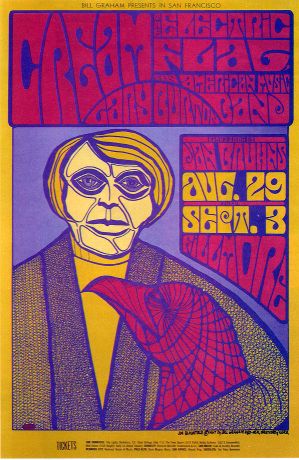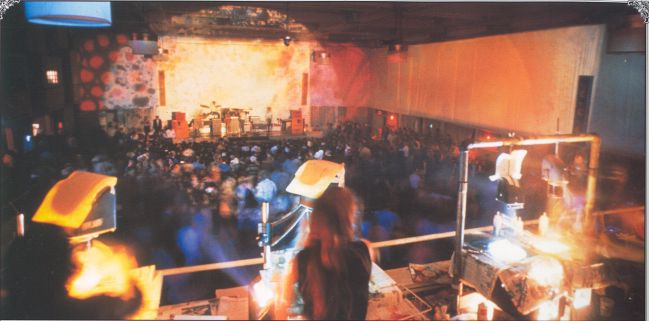

3rd September 1967.
Cream had been invited to play at the Monterey Pop Festival with The Who and Hendrix, but Stigwood refused. Based on Pennebaker’s film, the right decision was made. Cream would have been overshadowed by the bravura performances of The Who and Hendrix and their brand of blues was well represented by Paul Butterfield, The Electric Flag and Steve Miller.
|
In San Francisco, Bill Graham was willing to take chances with overseas
bands. For Cream’s gigs he hedged his bets by making it a double bill with the Paul
Butterfield Blues Band. At this time this was the best and most innovative blues/rock band
in the States. For Cream it meant they had to do something new and it was the Paul
Butterfield band that pointed the way with Mike Bloomfield’s ground breaking
"East-West" (a brilliant 28 min version from early 1967 is available on
"East-West Live’). Bill Graham’s approach was to run two shows. Cream played their typical sets but on the late show they were expected to stretch out. They completed their set and found the audience demanding "more, more" but they had exhausted their repertoire. Clapton looked at Baker and Ginger said "play, play anything". Clapton launched into a frenetic instrumental improvisation at maximum volume with Baker and Bruce participating with relish, as it was what they did best. |
For the rest of their residence they rebuilt their sets blending the song length numbers such as "Tales of Brave Ulysses", "Lawdy Mama" etc with those songs that were natural vehicles for jamming such as "Spoonful", "Sweet Wine" and "NSU". The individual showcases were also stretched. Over this period the improvisations became more freewheeling as Eric grew in confidence. Jack and Ginger were effectively back in a jazz trio but with their "Eric Dolphy".
This audience recording of the Sunday documents this transitional period Cream clearly overwhelms the pa as the guitars, and even the drums, are very much to the fore. Clapton is playing through dual stacks as evidenced by the high volumes he achieves relative to the drums/vocals and even the bass
The standard bootleg order starts with "Spoonful" however this is from the 2nd set. "Tales of Brave Ulysses" was the start of the first set. Of the song forms: Ulysses is a typical rendition as the opener, a tight Sunshine is still in the song form, and a Lawdy which is no advance on 1966’s Klooks Kleek version. An excellent Sleepy has now evolved to the typical 6-8 minute performance including the lead break from Jack.
It is the Jams that hold the maximum interest. An excellent "NSU" is played at a fast tempo but not as fast as later versions, Sweet is quite free form, for such an early stage, with Clapton extending his experimentations, Stepping is particularly exciting with Eric working through the wide range of his technical and tonal bag.
"Spoonful" is the most exciting performance in which Clapton slides away from the pentatonic scale into modal form. John Platt, in his excellent book "Disraeli Gears", describes it thus: "Instead of Clapton’s usual dazzling barrage of blues riffs, ancient and modern, he plays his entire solo as something closer to an Indian raga.". However Eric is actually referring to "East-West", which is a very clear compliment to Mike Bloomfield, who was on the bill.
The above comments have concentrated on Clapton simply because he was the one that made the conceptual/technical jump. Jack and Ginger had been there from their jazz days and now Clapton joined them.
Probably the greatest impact on all three from these ‘Fillmore’ days was that they could just play their instruments and get an ecstatic response from the audience. They extended this through the rest of the tour to varying responses. When they returned in ’68 it was to packed houses as the word had spread and there was a burgeoning generation of listeners to a new musical genre called Rock.
Sound quality is only reasonable with hard stop starts, mike sounds and body masking. However the performance, while not as revolutionary as Platt states, is excellent. A week later at Brandeis U, they improvised intensively and extensively – the 20min NSU is equal to half a Fillmore set!

The Fillmore from the Lightshow platform in mid '67
© Graeme Pattingale 1999